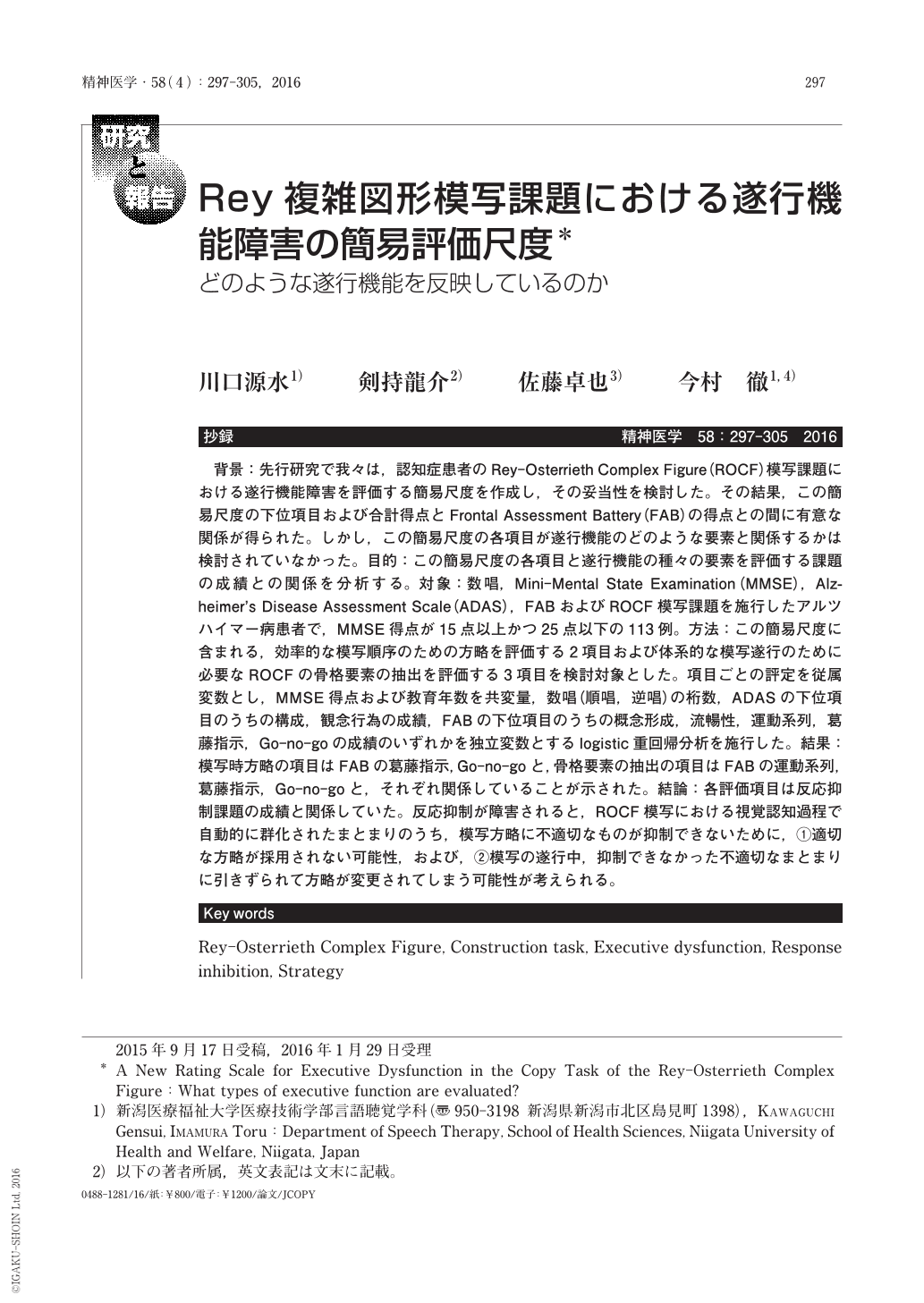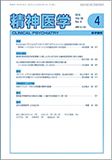Japanese
English
- 有料閲覧
- Abstract 文献概要
- 1ページ目 Look Inside
- 参考文献 Reference
抄録
背景:先行研究で我々は,認知症患者のRey-Osterrieth Complex Figure(ROCF)模写課題における遂行機能障害を評価する簡易尺度を作成し,その妥当性を検討した。その結果,この簡易尺度の下位項目および合計得点とFrontal Assessment Battery(FAB)の得点との間に有意な関係が得られた。しかし,この簡易尺度の各項目が遂行機能のどのような要素と関係するかは検討されていなかった。目的:この簡易尺度の各項目と遂行機能の種々の要素を評価する課題の成績との関係を分析する。対象:数唱,Mini-Mental State Examination(MMSE),Alzheimer's Disease Assessment Scale(ADAS),FABおよびROCF模写課題を施行したアルツハイマー病患者で,MMSE得点が15点以上かつ25点以下の113例。方法:この簡易尺度に含まれる,効率的な模写順序のための方略を評価する2項目および体系的な模写遂行のために必要なROCFの骨格要素の抽出を評価する3項目を検討対象とした。項目ごとの評定を従属変数とし,MMSE得点および教育年数を共変量,数唱(順唱,逆唱)の桁数,ADASの下位項目のうちの構成,観念行為の成績,FABの下位項目のうちの概念形成,流暢性,運動系列,葛藤指示,Go-no-goの成績のいずれかを独立変数とするlogistic重回帰分析を施行した。結果:模写時方略の項目はFABの葛藤指示,Go-no-goと,骨格要素の抽出の項目はFABの運動系列,葛藤指示,Go-no-goと,それぞれ関係していることが示された。結論:各評価項目は反応抑制課題の成績と関係していた。反応抑制が障害されると,ROCF模写における視覚認知過程で自動的に群化されたまとまりのうち,模写方略に不適切なものが抑制できないために,①適切な方略が採用されない可能性,および,②模写の遂行中,抑制できなかった不適切なまとまりに引きずられて方略が変更されてしまう可能性が考えられる。
Background:We developed a simple rating scale for assessing executive dysfunction in the copy task of Rey-Osterrieth Complex Figure (ROCF) and evaluated the validity in patients with dementia (Kenmochi et al, 2013). The total score and the score of each assessment item in this rating scale were significantly correlated with the total score of the Frontal Assessment Battery (FAB). However, it was not investigated which types of executive function were related to the rating scale. Objective:To evaluate the relation of the assessment items of the rating scale to the tasks for assessing various types of executive function. Subjects:113 patients with Alzheimer's disease who underwent digit span, Mini-Mental State Examination (MMSE), Alzheimer's Disease Assessment Scale (ADAS), FAB and the copy task of ROCF, and who scored 15 or more and 25 or less in the MMSE. Methods:The rating scale includes 2 items to assess the strategy of copying in efficient order and 3 items to assess the extraction of configural elements for systematic copying. We performed multiple logistic regression analysis with each score of the 5 items as dependent variable, MMSE score and educational attainment as covariates, and one of the following as an independent variable:digit spans (forward, backward), scores of Construction and Ideational Praxis tasks in ADAS, and scores of Similarities, Fluency, Motor Series, Conflicting Instructions and Go-no-go tasks in FAB. Results:The items to assess copying strategy were associaed with the Conflicting Instructions and the Go-no-go tasks of the FAB, and the items to assess the extraction of configural elements were associated with the Motor Series, the Conflicting Instructions, and the Go-no-go tasks of the FAB. Conclusion:Each assessment item of the rating scale was related to the tasks for response inhibition. Patients with impaired response inhibition may not inhibit inappropriate visual groupings from those produced automatically in the perceptual process of copying ROCF. The inappropriate groupings may suppress an appropriate strategy for copying and may lead to changing strategies during copying.

Copyright © 2016, Igaku-Shoin Ltd. All rights reserved.


